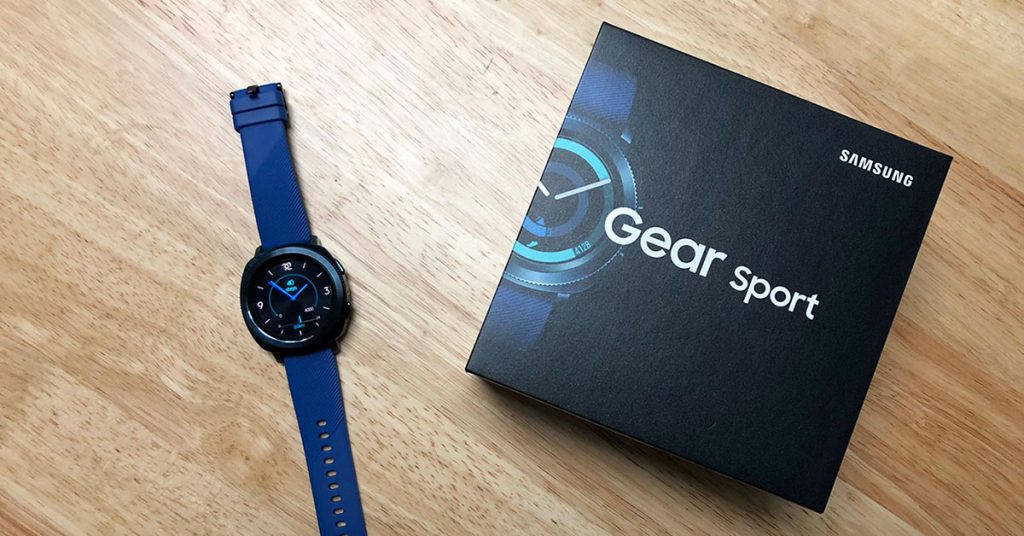- The Gear Sport is Samsung’s latest entry in the smartwatch category, with its focus being exercise and sporting activity.
- Features include fitness tracking, heart rate monitoring, water resistance of up to 50 metres, and a battery life of 2-3 days on average.
- The Gear Sport retails for around RM1,299 and can be purchased online.
The Samsung Gear Sport—the latest in the line of smart watches from the South Korean tech giant—hit the stores in December last year and come as the successor to the Gear S3 that released in late 2016.
The feature set of the Gear Sport—if not already obvious—focuses on exercise and sporting activities. This is evident in its design, with its silicone strap and lightweight construction making it apt for the outdoors.
It one-ups its predecessor S3 by now being water resistant up to 5ATM or 50 meters, making it suitable for swimming or light aquatic sports as well.
Great Build Quality
The Gear Sport comes in a smaller and more lightweight build compared to the Gear S3, and the overall quality of its construction is very satisfactory.
The rotating bezel that’s now a trademark Samsung feature works well enough, with satisfying clicks to provide tactile feedback when going through menu items. This feature feels extremely natural as means of controlling the device, and I fail to see different way that would work better.

The straps that come with the Gear Sport are made of silicone and give off the impression that they’d feel very much at home in wet environments. This goes hand in hand with the Gear X’s water resistance, and swimmers will appreciate having the option to carry a fitness tracker with them into the pool.
The straps can also be removed and replaced with other 20mm straps, giving users added options when it comes to style.
On the front face, users will enjoy the 1.2 inch AMOLED display with its vibrant colours and more than adequate brightness. Text was easy to read and visibility was a non-issue in bright daylight.
The two buttons at the side of the Gear X also function well enough; their textured shells are helpful for users to distinguish them from the slick surface of the watch case.
The watch is charged through an accompanying dock that connects via Micro-USB, and touts three days of battery life. I found real-world performance closer to two days with moderate use, which I thought to be pretty decent, all things considered.

You can also customise the watch face with themes; our favourite was the Fallout one.
Minor Imperfections
When it came to real world performance, the Gear Sport performed as well as you’d expect, with only a few minor issues that got in the way of comfortable everyday use.
First, what I didn’t like were the silicone straps that came bundled with the device. During workout sessions, wearing the Gear X became uncomfortable on the wrist due to the poor breathability of the strap.
My wrist felt hot after a few minutes, and profuse sweating soon followed. Even during normal use, the silicone straps still didn’t feel good on my wrists, and I would recommend users to purchase a thinner and more breathable watch strap elsewhere, such as a nylon NATO or a zulu strap.
Also, I noticed that the in-built pedometer on the Gear Sport acted a bit trigger-happy in its tracking of movement.
I took the tracking performance of the Gear Sport and compared it to that of my colleague’s Huawei Band 2 Pro, and found the Gear Sport identified and registered movements that were not footsteps more often than the Huawei. This didn’t happen too often, however, and shouldn’t have much impact on the decisions of interested buyers.
Fitness Tracking Done Right
These two blips aside, I found the Gear Sport to be pretty great both as a fitness tracker and a smartphone companion.
On the fitness side of things, the watch performs flawlessly alongside the Samsung Health app. Pairing the watch with my smartphone was a cinch, and all the information gathered through fitness tracking was laid out handily in the Samsung Health app.
I was able to view the distance covered, the amount of calories burned, and my average heart rate in BPM throughout each day.
There were also a ton of other fitness tracking capabilities such as calorie counting, sleep-pattern monitoring, and even the option to keep tabs of my caffeine intake.

Not being a fitness-junkie, I felt that a lot of these options were more novel than practical—especially when some of the counters (such as calorie and water intake) required me to input my consumption manually.
As a whole, however, I feel that having all these different options doesn’t hurt, and that the more health-conscious individual out there may actually find use for such features—especially as they’re all easy enough to use and perform without a hitch.
Working Alongside Android
The other draw of the Gear Sport is its functionality as a smartphone companion, which I—as one who isn’t used to wearing a smartwatch—found to work pretty much competently.
Used in tandem with my own non-Samsung smartphone, all the features functioned as expected when synced with the Samsung Gear App on my phone. There were no syncing issues, and the staple every day utilities that I used such as email, WhatsApp, and even my daily alarm all connected and played nicely with the watch.
Also, the option to reply to my WhatsApp messages through either handwriting recognition or the on-screen keyboard might probably sound impractical because of the size of the screen, but is still a handy function to have.

Throughout my time using the watch, I grew to appreciate all the other features that were available on the Gear Sport, and I came to find myself really liking the ease of use for many of its functions.
I enjoyed being able to see notifications, read my messages, check social media updates, and even use Spotify’s offline feature without having to remove my phone from my pocket.
However, when the time came to finally let go of it, I didn’t feel that sensation of being lost—like when you suddenly realise that you’ve left your phone behind while already on the way to work.
I didn’t miss using it too much, and found it very easy to go back to doing all my daily tasks on my phone. I decided then that the Gear Sport was indeed a very nice gadget to have, but not one I couldn’t live without.
Verdict?
In closing, the question still remains: would I recommend buying this watch?
Easily enough, my answer is “yes”—for the most part. I’d recommend the Gear Sport to buyers already seeking out a device to act as an accompaniment for their smartphone, and I’d especially recommend it to fitness enthusiasts looking for such a device with the added features of a fitness tracker.
For the ones still new to owning a smartwatch, and who are still undecided about whether to get one—I’d caution them to first understand that while the Gear Sport is a very good piece of tech that will serve you well, it is not an everyday essential.
Sure, it makes life easier and does its fitness duties very well, but with a price tag of RM1.3k, buyers should make their purchase only if they understand what they’re spending their money on, and what they expect to get out of their new smartwatch.

















